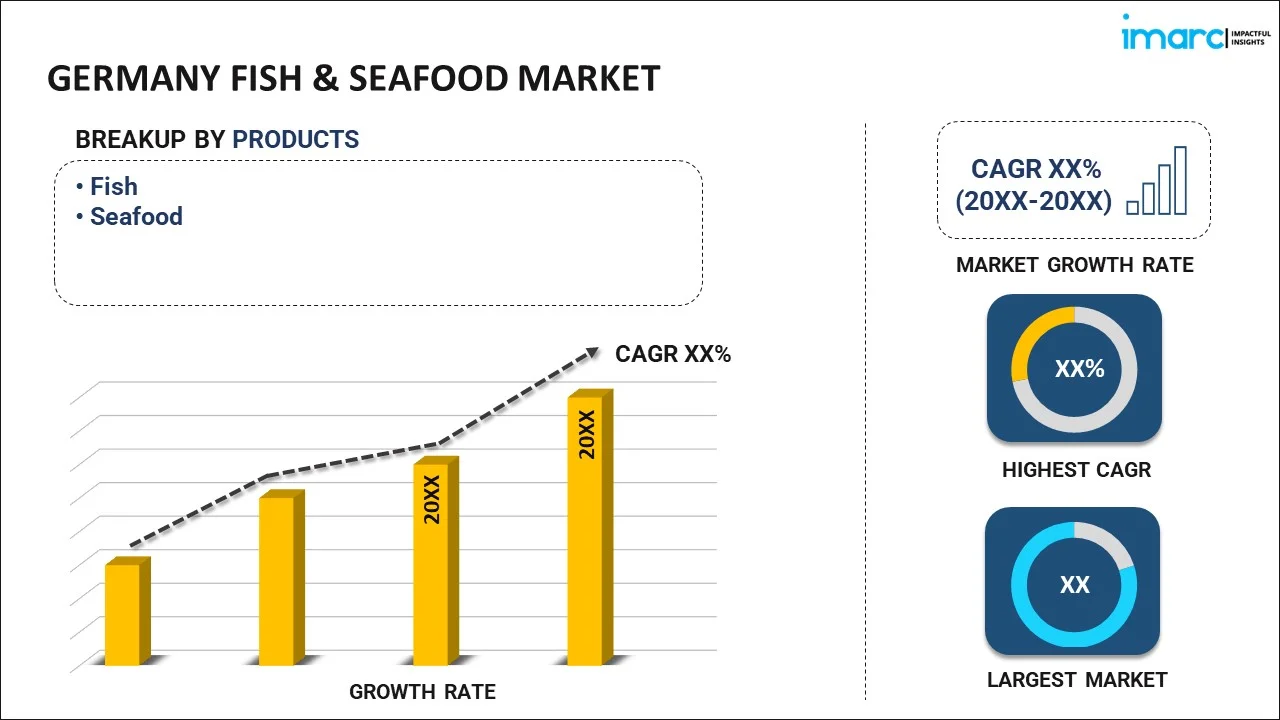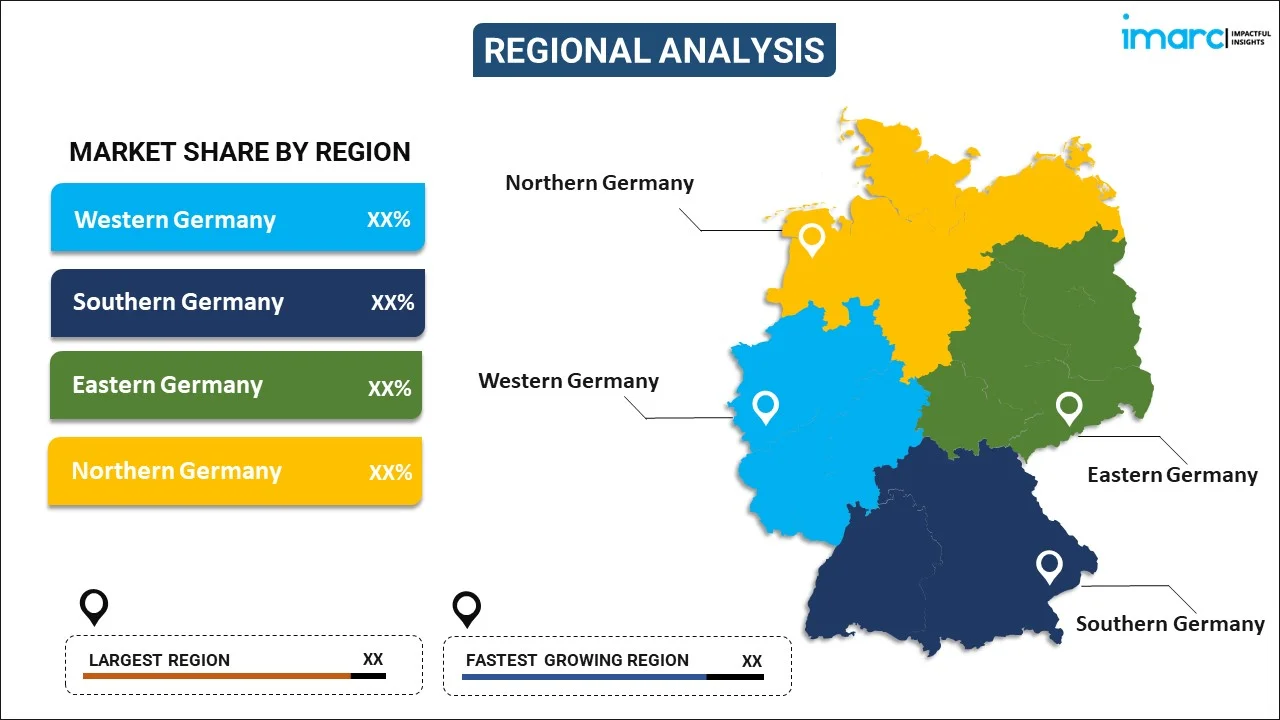
Germany Fish & Seafood Market Report by Product (Fish, Seafood), Form (Fresh, Frozen, Canned, Cured), Distribution Channel (Offline, Online), and Region 2025-2033
Germany Fish & Seafood Market Overview:
The Germany fish & seafood market size reached USD 16.7 Billion in 2024. Looking forward, IMARC Group expects the market to reach USD 25.3 Billion by 2033, exhibiting a growth rate (CAGR) of 4.15% during 2025-2033. The rising health consciousness, increasing demand for protein-rich diets, expanding aquaculture practices, technological advancements in processing, and growing consumer preference for diverse and convenient seafood products are some of the key factors creating a positive outlook for the market.
|
Report Attribute
|
Key Statistics
|
|---|---|
|
Base Year
|
2024
|
|
Forecast Years
|
2025-2033
|
|
Historical Years
|
2019-2024
|
|
Market Size in 2024
|
USD 16.7 Billion |
|
Market Forecast in 2033
|
USD 25.3 Billion |
| Market Growth Rate 2025-2033 | 4.15% |
Germany Fish & Seafood Market Trends:
Rise of sustainable fishing practices
In 2018, Germany produced 0.3 million tonnes of fish, valued at USD 467.1 million. Aquaculture contributed 29% to this value, while 71% came from fisheries. This reflects a significant reliance on wild resources despite global concerns over overfishing. However, with the adoption of Sustainable Development Goal 14 (SDG 14) of the 2030 Agenda for Sustainable Development, Germany committed to ending overfishing by 2020 and regulating fishing based on scientific insights. Consequently, this has led to a shift towards sustainable practices. Moreover, certification programs like the Marine Stewardship Council (MSC) and Aquaculture Stewardship Council (ASC) are gaining prominence, setting standards for responsible fishing and farming. In addition to this, rising consumer preferences for certified sustainable seafood, incentivizing retailers and restaurants to prioritize such products is boosting the demand for ecological variants, which is ensuring the conservation of marine ecosystems and securing a stable seafood supply for future generations.
Growing demand for ready-to-eat (RTE) seafood products
Busy lifestyles and the need for convenient meal options have led to an increase in the popularity of RTE seafood. These products, which include pre-cooked, smoked, canned, and marinated seafood, offer consumers a quick and easy way to enjoy nutritious meals without the hassle of extensive preparation. The expansion of the RTE segment is supported by advancements in packaging technologies, such as vacuum-sealing and modified atmosphere packaging, which help maintain the freshness and quality of seafood products. Additionally, innovative product offerings, such as seafood salads, sushi kits, and seafood snacks that cater to diverse consumer preferences are further boosting the demand for RTE seafood.
Advancements in aquaculture technology
Aquaculture, or fish farming, is becoming increasingly important as wild fish stocks dwindle and demand for seafood rises. Significant technological advancements in aquaculture, such as recirculating aquaculture systems (RAS), integrated multi-trophic aquaculture (IMTA), and genetic enhancements are enhancing the efficiency and sustainability of fish farming. RAS allows for the controlled rearing of fish in a closed-loop system, reducing water usage and minimizing environmental impact. IMTA integrates different species, such as fish, shellfish, and seaweed, in a single system, creating a balanced and sustainable ecosystem. In order to satisfy the increasing demand for seafood around the world while reducing the negative environmental effects of traditional fishing methods, these technological advancements are playing a crucial role in market expansion.
Germany Fish & Seafood Market News:
- In April 2024, In Hamburg, Germany-based startup Bluu Seafood opened the first fish farming pilot plant in Europe. The 2,000-square-meter facility, which grew out of a small lab in Lübeck, has new fermenters to grow cells of rainbow trout and Atlantic salmon. The current 65-litre capacity can scale up to 2,000 litres.
- In November 2023, Ordinary Seafood launched its METRO stores throughout Germany to sell its plant-based seafood products. With this expansion, a larger range of plant-based substitutes for conventional seafood is now available, providing consumers looking for eco-friendly food options with creative and sustainable options.
Germany Fish & Seafood Market Segmentation:
IMARC Group provides an analysis of the key trends in each segment of the market, along with forecasts at the country level for 2025-2033. Our report has categorized the market based on product, form, and distribution channel.
Product Insights:

- Fish
- Seafood
The report has provided a detailed breakup and analysis of the market based on the product. This includes fish and seafood.
Form Insights:
- Fresh
- Frozen
- Canned
- Cured
A detailed breakup and analysis of the market based on the form have also been provided in the report. This includes fresh, frozen, canned, and cured.
Distribution Channel Insights:
- Offline
- Online
The report has provided a detailed breakup and analysis of the market based on the distribution channel. This includes offline and online.
Regional Insights:

- Western Germany
- Southern Germany
- Eastern Germany
- Northern Germany
The report has also provided a comprehensive analysis of all the major regional markets, which include Western Germany, Southern Germany, Eastern Germany, and Northern Germany.
Competitive Landscape:
The market research report has also provided a comprehensive analysis of the competitive landscape. Competitive analysis such as market structure, key player positioning, top winning strategies, competitive dashboard, and company evaluation quadrant has been covered in the report. Also, detailed profiles of all major companies have been provided.
Germany Fish & Seafood Market Report Coverage:
| Report Features | Details |
|---|---|
| Base Year of the Analysis | 2024 |
| Historical Period | 2019-2024 |
| Forecast Period | 2025-2033 |
| Units | Billion USD |
| Scope of the Report | Exploration of Historical Trends and Market Outlook, Industry Catalysts and Challenges, Segment-Wise Historical and Future Market Assessment:
|
| Products Covered | Fish, Seafood |
| Forms Covered | Fresh, Frozen, Canned, Cured |
| Distribution Channels Covered | Offline, Online |
| Regions Covered | Western Germany, Southern Germany, Eastern Germany, Northern Germany |
| Customization Scope | 10% Free Customization |
| Post-Sale Analyst Support | 10-12 Weeks |
| Delivery Format | PDF and Excel through Email (We can also provide the editable version of the report in PPT/Word format on special request) |
Key Questions Answered in This Report:
- How has the Germany fish & seafood market performed so far and how will it perform in the coming years?
- What has been the impact of COVID-19 on the Germany fish & seafood market?
- What is the breakup of the Germany fish & seafood market on the basis of product?
- What is the breakup of the Germany fish & seafood market on the basis of form?
- What is the breakup of the Germany fish & seafood market on the basis of distribution channel?
- What are the various stages in the value chain of the Germany fish & seafood market?
- What are the key driving factors and challenges in the Germany fish & seafood?
- What is the structure of the Germany fish & seafood market and who are the key players?
- What is the degree of competition in the Germany fish & seafood market?
Key Benefits for Stakeholders:
- IMARC’s industry report offers a comprehensive quantitative analysis of various market segments, historical and current market trends, market forecasts, and dynamics of the Germany fish & seafood market from 2019-2033.
- The research report provides the latest information on the market drivers, challenges, and opportunities in the Germany fish & seafood market.
- Porter's five forces analysis assist stakeholders in assessing the impact of new entrants, competitive rivalry, supplier power, buyer power, and the threat of substitution. It helps stakeholders to analyze the level of competition within the Germany fish & seafood industry and its attractiveness.
- Competitive landscape allows stakeholders to understand their competitive environment and provides an insight into the current positions of key players in the market.
Need more help?
- Speak to our experienced analysts for insights on the current market scenarios.
- Include additional segments and countries to customize the report as per your requirement.
- Gain an unparalleled competitive advantage in your domain by understanding how to utilize the report and positively impacting your operations and revenue.
- For further assistance, please connect with our analysts.
 Request Customization
Request Customization
 Speak to an Analyst
Speak to an Analyst
 Request Brochure
Request Brochure
 Inquire Before Buying
Inquire Before Buying




.webp)




.webp)












